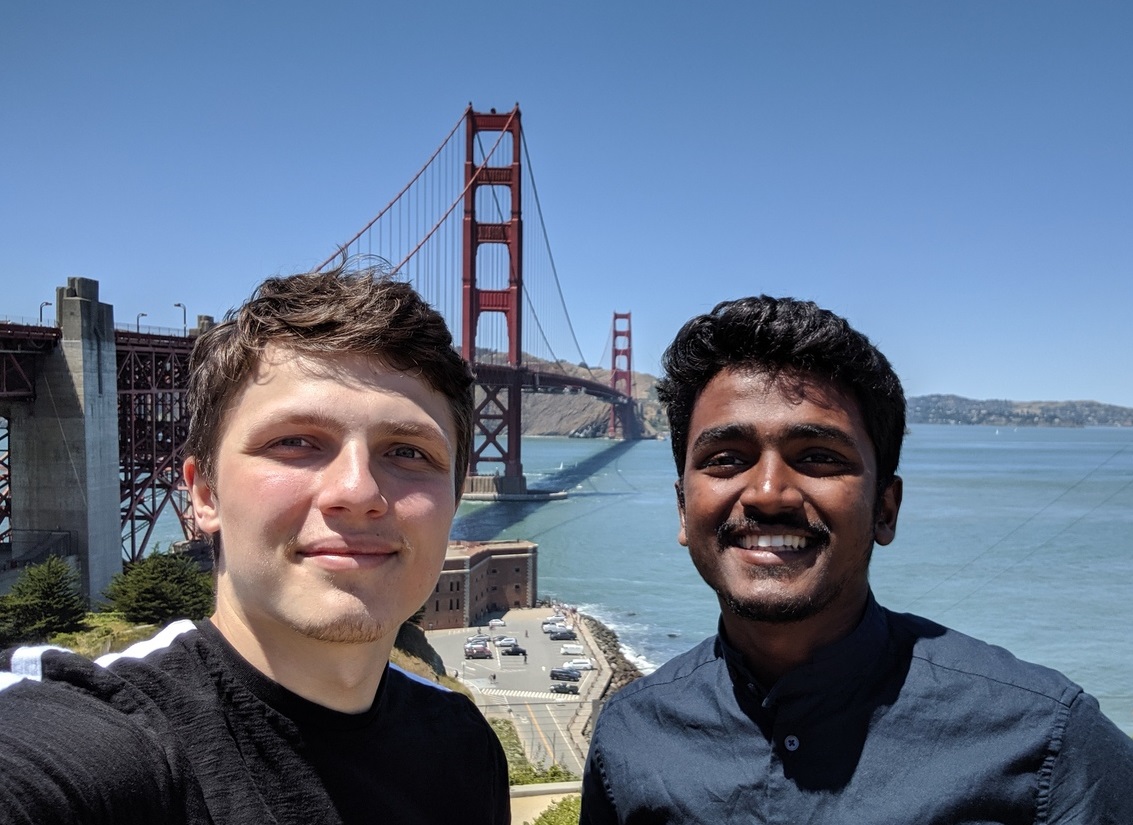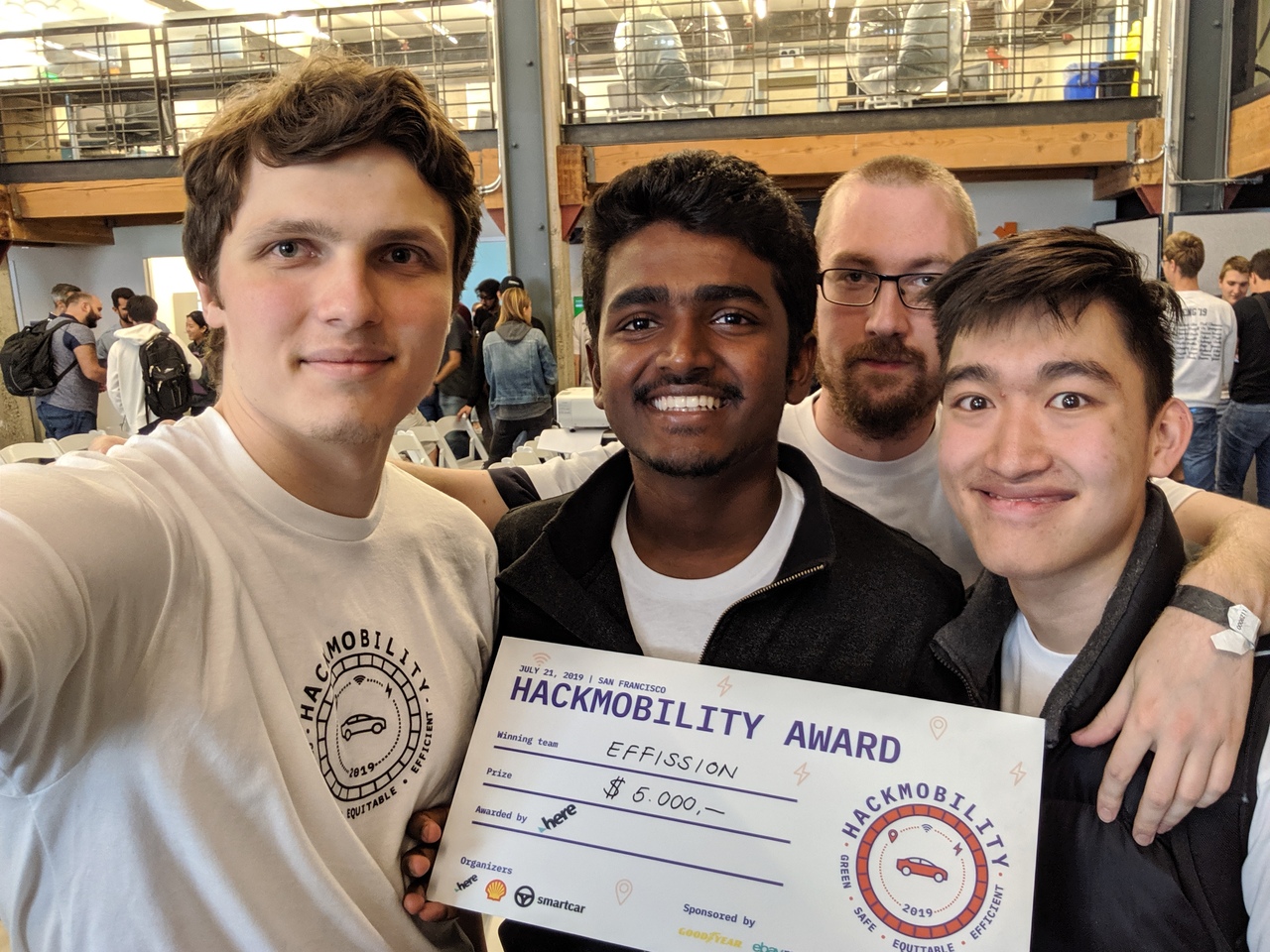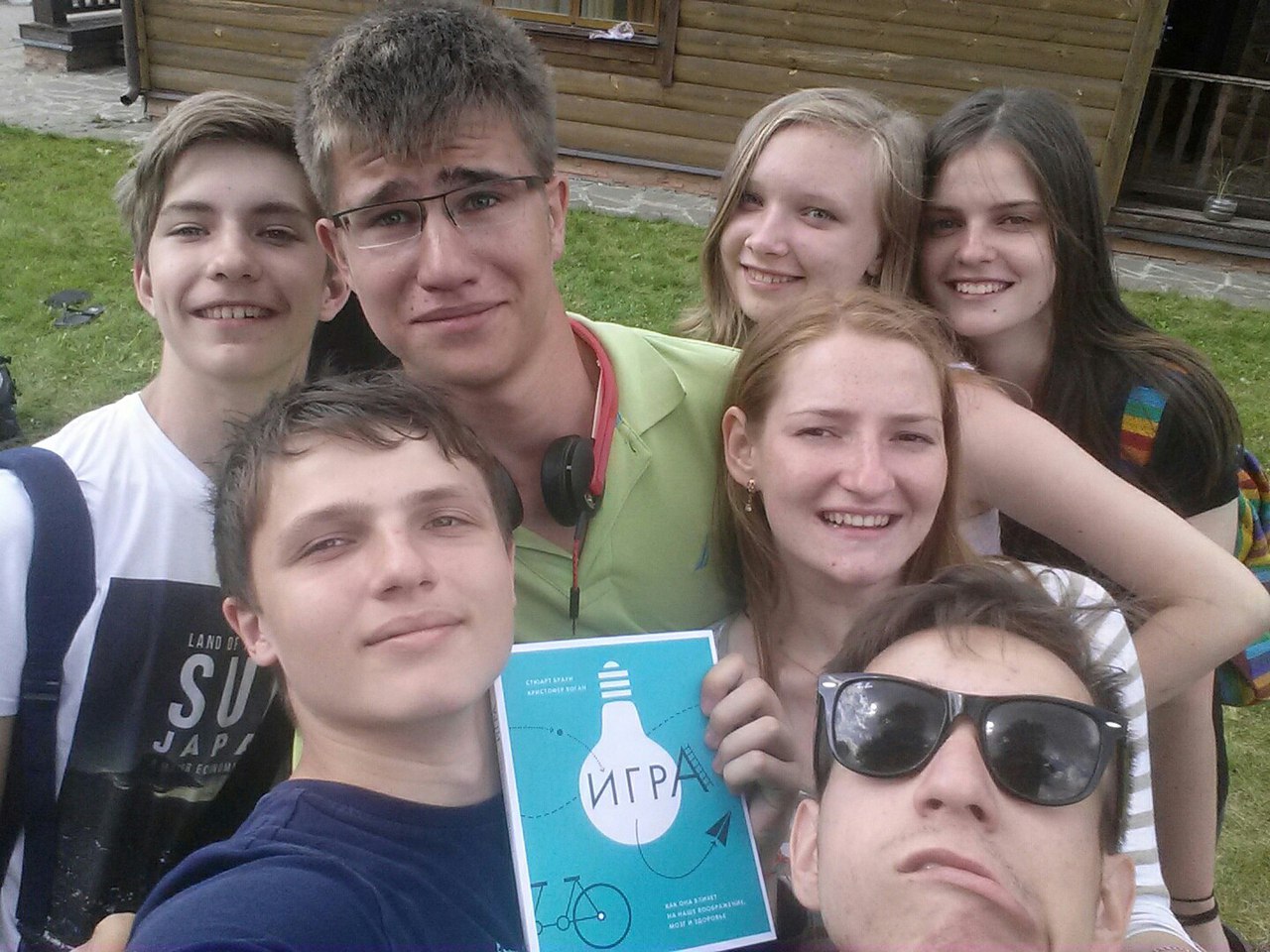
Dmitry Dolgopolov (CTO) and Kesava Kirupa Dinakaran (CEO) are co-founders of DigitalBrain .
I met Dmitry in 2015. I was a counselor, and Dima was a schoolboy. I taught the pioneers to walk on the slackline, to misalign the neurointerface and code in handcuffs , and Dima was playing some kind of game. And then a week ago he told me that he passed the Y Combinator summer batch with his startup DigitalBrain and raised $ 3.4 million . I decided to ask him in more detail.
- Hello. Tell me about yourself.
- At the moment I am 20 years old. After graduating from high school in Russia, the next stage of my life was going to college in America (in the Bay Area) to study computer science. And last year, my co-founder Keishev and I founded DigitalBrain, a YC startup where we are working on the next generation of customer support software.
- Where and how did you learn to program?
- Back in school, I learned to program for Android. Initially, it was a love of games. I saw my classmates play various games on their iPhones. At that time, not everything that was on iOS was on Android. Unfortunately, I could not afford to buy an iPhone, but I really liked one game for its aesthetics and did not leave me indifferent. I decided to write this game myself and started googling how to write games for Android.
I spent many sleepless nights at StackOverflow and in Android documentation, as well as in smaller blogs and articles on Habré. I was motivated by the constant spike in dopamine when I was solving a bug that I spent several hours on. Through trial and error, the game was written and subsequently rewritten three times as I found ways to improve the architecture of the code. In the end, it took me three months to write this game . Then I posted it on Google Play, which in turn became my first earnings.

Shades 2.0 game.
Indeed, it was difficult for me without any mentor, but the main result of this activity, I consider the development of my strong intuition in development, which undoubtedly helps in other areas of life.
- What other projects did you have, what did you implement, in what languages?
- Most of my projects were from hackathons or my personal experiments, which I wrote for Android and the web. Java (Android), NodeJS, Python, React.
- Which 3-5 startups do you like the most now?

- Boom Supersonic - build supersonic passenger aircraft. Founder was not an engineer, but he set himself a lofty goal. A few weeks ago, they announced on Twitter that they had assembled the first working unit of their plane.
- Notion — pre-seed , , ( -), 4 . pre-seed $50M $2B. ( 2.5% $50M).
- Stripe — - , API - . , Amazon , , .
- How did you move to Silicon Valley?
- In 2016, when the time came to enter the university, I knew exactly what I liked and what I was good at - programming. I had a choice: to follow the usual path and go to a university in Russia, or take the risk and go to the Bay Area with a small budget, while not knowing anyone who would live abroad or speak not only Russian.
Two aspects pushed me to go to America.
Firstly, by that time my curiosity had already made me understand that if you want to learn something, any information can be found on the Internet. Thus, it turns out that the only significant value of the university is the community with which you will contact through this university.
Secondly, I realized that the apparent risk of moving for me was extremely small, because those potential acquaintances and cultural experiences obviously outweighed the likelihood of the worst outcome - I would run out of money and have to return to Russia.
My family strongly supported me in my decision and logic of actions, for which, of course, I am very grateful to her.
On average, a year at the American University (taking into account the payment of everything yourself) will cost $ 70,000-80,000 per year. At community college, this price drops to ~ $ 12,000 per year for tuition. The usual plan for many foreign students: after 2-3 years in community college, you transfer to the university, spend a couple more years there (instead of four) and eventually get a bachelor's degree. So, following this plan, I entered a community college in the Valley.
- How did you learn 12 languages?
- After moving to the Bay Area, I was amazed by the diversity of cultures, languages spoken by people, diversity of views. I love to be among representatives of different cultures and study their views on the world, because from this you can always take out something useful for yourself and apply it in your life.
For example, in particular the Spanish language has drawn me through the culture. I really liked the food - Mexican, Argentine, Colombian, Spanish ... I was attracted by people, their style of thinking and communication. At one point, I wanted to understand this culture better, to become a part of it. And the only way to truly understand a culture is to study its language. I believe that only by speaking in the language of a person can you truly understand his train of thought. So, I decided to set myself the goal of learning this language at a level that would allow me to communicate freely in it.
I can talk for hours about how to effectively learn languages. However, in my opinion, the easiest and most effective way to learn to speak a language is, oddly enough, to speak it.
Now there are many resources on the Internet (most of which are free) that allow you to connect with a person anywhere in the world and start communicating with them. Add to this a little motivation, and if you study a language every day, then any language is quite an achievable thing even without a teacher.
Having found some of these friends online and practicing the language every time I, for example, went to Mexican restaurants or chatted with my friends from El Salvador in college, after 4 months I was able to speak fluent Spanish.
Now I can speak English in a day, watch a show in Spanish or read the news in French. In addition, I know a few more languages at a more basic level and could easily communicate with native speakers of these languages.
- What are the most useful learning resources you've come across?
- High Output Founders' Library — , user interviews .
- YC Startup Library — YC , Bay Area, , .
(. .: , YC Startup Library . : t.me/yclibrary)
- Growth.Design — product design, .
Plus, Twitter is a very powerful resource for startups. If you subscribe to the right people, then the recommendations will come across a lot of good content. If you already have an account with subscriptions to everything, then I recommend creating another account to subscribe to cool startups, for example:
- What are you reading and watching now in order to improve your a) professional skills b) general knowledge about the world
- Very good resources that I use at the moment:
- Lectures at Stanford, MIT
- Company blogs in later stages (Figma, Apple, Slack, etc)
- Books and Youtube on any topic that interests me
If you are just starting your journey in startups, then I advise you, in particular, to start with the bible of startups - "From zero to one" by Peter Thiel (cycle of translations on Habré: Course of lectures "Startup". Peter Thiel. Stanford 2012 ).
- Tell us how you were homeless in the Valley?
- Neither my co-founder nor I had a lot of money to live in the Bay Area. I lived for a long time in the kitchen in an apartment in San Jose with my friends to save money on rent. I think I had the cheapest rental in the entire Bay Area back then. At the time I met my co-founder, he was living with three other people in a garage in Palo Alto.
I remember even then it seemed to me that sometimes I was “chic” and spend too much money on food, when $ 300 came out in a month instead of $ 250. I recently asked my American friends how much they spend on food and found that on average they spend $ 600-800 per month.
- How did DigitalBrain happen?
- My co-founder Keishev and I met at a hackathon in San Francisco. From the first hackathon, we realized that we would work together and that we have very complimentary skills: I am more technical, I can quickly understand technology, design and implement anything, I know how to create a high-quality user experience. And he has great business intuition, presentation and communication skills. In addition, we have a very similar background and views on tasks that are interesting for both of us to solve.
The story began with the fact that at one point Keishev wrote to me and offered to go to a hackathon organized by Shell in order to win a prize of $ 5,000. We both had little money, he literally had $ 9.48 in his bank account. We came to this hackathon and after a sleepless night with coffee and sandwiches, we won it.

Winning hackathon
After that, we won hackathons over and over again and practically learned how to “hack” hackathons and significantly increase the chances of winning. This allowed us to live on money from hackathon winnings for almost six months.
In our last hackathon, our project was a chrome extension that saw the content that you scrolled, and using NLP (Natural Language Processing) understood the topic of the site and automatically sent it to the correct history directory. For example, if you read something about games on IGN, it was sent to games / computer games.
The company that organized this hackathon loved the idea so much that they told us: "Guys, if you really do this, we are ready to pay for it." So we registered DigitalBrain and started working together, having got our first client.

Another hackathon won.
- What was the initial hypothesis, and in what then did you pivot?
- When we got to YC, we were working on automatic code documentation (iteration of the original idea). Immediately after the interview, we were told: “We really like you guys, but we are not really confident in the idea” (“We really like you guys, but we are not quite sure about this idea”). Naturally, it was hard feedback for us. This did not mean that we needed to change the idea (for example, AirBnB received the same feedback when they got to YC with their idea), but it pushed us to think.
We had 3 weeks to come to a decision before starting the batch. And in the end we realized two things.
First, at that time YC would not have been so useful with the software documentation, since were too early.
Secondly, with the documentation of the code, it was too difficult for us two young founders with no experience of interacting with the corporate sector to convince the company to entrust us with access to their code base (we used github api access to generate documentation).
We decided to change the idea and knew which area to go to. On more than one occasion, in our interviews with users, company employees complained that modern customer support tools are extremely slow and complex programs that were written in the 2000s and have not changed much since then, despite to new technologies. For three weeks, we conducted five to six interviews a day with users of such systems and found that making the system even a little faster would save companies a lot of money.
- How did you develop the current MVP?
- As a CTO, I did MVP design and development for a couple of weeks while Keishev was looking for his first clients.
For design, I prefer to use paper and then transfer everything to Figma. In A4 notebook I sketch several versions of the interface and choose the one that suits the best.
Every detail is important because it affects how the user perceives the product. For example, have you ever noticed that on Instagram caption is also the first comment to a photo? If there is already a comment under the photo (even if it is a caption), then it is much easier for people to decide to write another comment. This makes Instagram a more social product than dribbble or tumblr.
- What is the essence of DigitalBrain?
“DigitalBrain is a feedback system that allows feedback agents to work twice as fast as if they were using traditional systems like Zendesk.
If you have ever communicated with a customer service via email to resolve a delivery issue with IKEA or Delivery Club, then you have definitely come across similar systems. These products are manually configured and this is often confusing. For example, some agents may spend 5 minutes on a response that is already in “saved responses”. Traditional systems lack measures to minimize this problem. We at DigitalBrain solve not only this problem, but many others, which can significantly increase the speed of response, and therefore increase customer satisfaction.
- How did you fill out the questionnaire in Y Combinator
- This was our second application to YC, so we only had to think about a new answer to the question "Tell us something surprising or amusing you've discovered." Everything else was quite similar to the first serve.

- How was the interview at YC
- Before the interview, we went through ~ 14 practice interviews with other more experienced founders that were at YC. We prepared very well and were ready with a lightning-fast answer to almost any question.
Despite all the preparation, YC's interview was one of the most disturbing experiences of our lives. We quickly went through the product, told our story and in the end we get a question for which we did not prepare from the word “at all”: “If you were not working on this idea, what idea would you be working on?”. After a short pause, Keishev replied: "Well ... we would be working on another problem that our users mentioned: company knowledge bases or tickets." They looked at each other. They said "thanks for the interview." And we said goodbye.
Our interview took only 6 minutes. Usually, all 10 minutes are filled with a barrage of questions. We were at a loss as we counted on it.
More often than not, you know the outcome of the interview. But here we both had no idea if this was the worst interview of our lives or if we got through. A few hours later they called us and said that we had passed.
- How did you search for the first users?
- One of the advantages of YC is the community. Often B2B YC companies start looking for users in companies from their own batch, then they expand the circle - “all YC companies”, then - acquaintances of “YC companies” and further. We were no exception. Our first users were companies from our batch.
- How was Demo Day?
- YC organized a great online Demo Day via Zoom. I think no one expected such a quality online event. Each founder was given a minute for a presentation and a slide with the most important information. In addition, a redesigned YC website was proposed for this, which showed which startup is currently presenting and information about them.
After the demo day, we got a lot of very good warm intros to interesting founders, investors and companies.
- You describe your project as “Superhuman for customer support agents”, what Superhuman materials did you take inspiration from while developing your product?
- How Superhuman Built an Engine to Find Product / Market Fit
- Delightful search: more than meets the eye
- Superhuman's Founder on How to Move Beyond Gamification
- Tell us about the 100 ms response principle, what is it, why is it important, what is the future of this?
- The principle of 100 millisecond response says that if less than 100 ms elapses from the user's action to the visible result, then this action feels instant.
Good interfaces have always been important to users. Especially the gen-Z generation, which is starting to work now, have become accustomed to good intuitive interfaces thanks to the efforts of companies such as Apple, Airbnb, Whatsapp, Telegram, and many others. Now, when a new generation gets a job, they have to work with terribly slow programs with an interface from 2007, such as Outlook, JIRA, Zendesk. Often, when they first interact with these enterprise products, they are in shock at the level of their working tools.
More and more people are beginning to understand the value of the lightning-fast interface. This greatly reduces the level of context switching, increases productivity and reduces stress levels without the constant load of the interface.
I think in the near future we will see more companies that beat large corporations due to a better interface as well.
- Tell us briefly about your co-founder?
- My co-founder grew up in a village in South India. As a child, he began to get involved in the Rubik's cube, participated in competitions and got into the Guinness Book of Records. After that, he entered UWC (United World College). This is an international school in India, in which teaching is focused on such global issues as sustainability, education, peace, multiculturalism.
Keishev came to America through the Three Dot Dash program, after which he decided to travel to the Bay Area for a couple of weeks to experience the culture of San Francisco. I decided to stay longer.
- You are 20 years old, the rest of the Russian YC graduates are over 25-30 years old. What is the “problem” of Russian-speaking 20-year-olds? Why does it not even occur to them to build an international startup, although there are hundreds of successful examples of 20-year-old Americans?
I think that, firstly, the problem is not themselves. The startup community in Russia is still at the beginning of its journey, and although there are massively successful pioneers like Durov, Segalovich and Volozh, these are still isolated cases.
Secondly, there are few centralized resources of information on running startups in Russia, like the YC Library or the High Output Founders' Library for the United States. Because of this, for example, finding a Product Market Fit is much more difficult and takes more time and effort. Also in comparison with the USA, where freshmen or sophomores already have a lot of experience in how to present themselves and pitch ideas convincingly, because they have had much more project activities since school than the average Russian student; Russian founders have to learn this themselves from scratch, again making many mistakes along the way.
Thus, the reason the majority of Russian founders at YC are over 25 is that in Russia they had to learn from their mistakes and literally “fight alone in the field”, grabbing at the opportunities they see along the way.
- How do you think this can be fixed? How can you help 18-20 year old talented guys so that they want and make startups? (Except for leaving Russia)
First of all, I think that you first need a great desire to start a startup, I would even say a lot of self-confidence. Because startups are a very emotionally exhausting and energy-consuming business, and not in every case it will contribute to the successful career of young guys.
However, for those who are confident in the choice of the path, I can advise a few things. First, help each other and ask as many questions as possible. You are in the same boat with most startups (other than competitors). Unfortunately, in Russia, many students (just like me before) have such a delusion that if you share your ideas, they will certainly be stolen, or if you share your experience, it will be worse for you, because you know it, and they are not ("zero sum game"). Fortunately, in the overwhelming majority of cases, the exchange of experiences is reflected positively ("play with a positive amount") for all parties, since people really want to help those who helped them. Moreover, when people share experiences, it adds value to the community.
Second, try to find mentors. We must try to interact with those communities that have already passed a similar path. Communicating with them will nudge you towards ideas that will 100% help you progress on your path.
Third, set VERY high goals. Be realistic, try to achieve the impossible, and then the result will surprise you.
Fourthly, you need to really work on the product, and not just discuss some ideas. Don't be afraid of failing. Even big mistakes are not as big as they seem.
- We met at the GoTo programming camp / school, what can you say about her?

- Honestly, GoTo- this is one of the best events of my school years. This is a camp in which a bunch of kids aged 14-18 are working for two weeks on unrealistically cool programming and robotics projects. There I met some of the smartest and most ambitious people in my life. If you are still at the school stage of your life and want to work on interesting projects and meet a bunch of other people with similar values, then I highly recommend going there!
I have not yet been in any other community where after a couple of weeks it feels like home.
- Now the Startup School for Future Founders has started , what do you wish for those schoolchildren and students who want to make their own startup at a global level?
- If you still have doubts before, for example, how to start working on a startup, ask yourself the question: "What is the worst thing that could happen to me if this business fails?" In the vast majority of cases, the answer is "nothing." As a last resort, you will find a better job using the startup experience in your resume, and when you have a great new idea, you will make a new and already super-successful startup.
Of course, I am always happy to help young founders. Private messages on Twitter are open ( https://twitter.com/dimadolgopolovn or dimadolgopolovn@gmail.com) and I am always happy to share advice and my skills with beginners (and not only) startups.
PS
Today is Dima's birthday. Happy Birthday!
And also ask questions in the comments, Dimadimadolgopolov promised to answer the most interesting ones.
PPS
- YCombinator in Russian - a Facebook group where Russian- speaking YC alumni help budding founders
- Silicon Pravda Chat in Telegram
- Translations of YC Startup Library materials
- Translations of all Paul Graham's essays